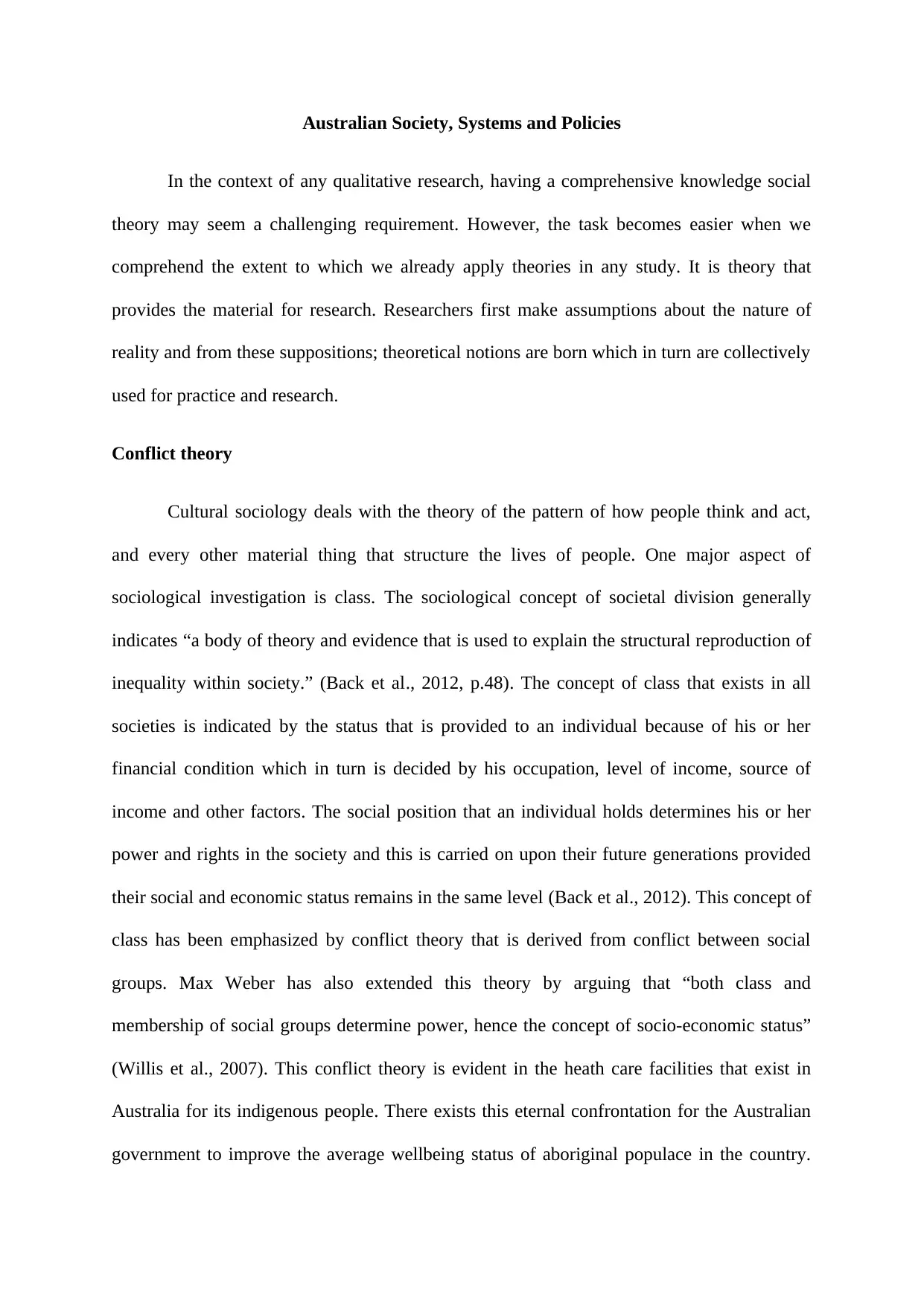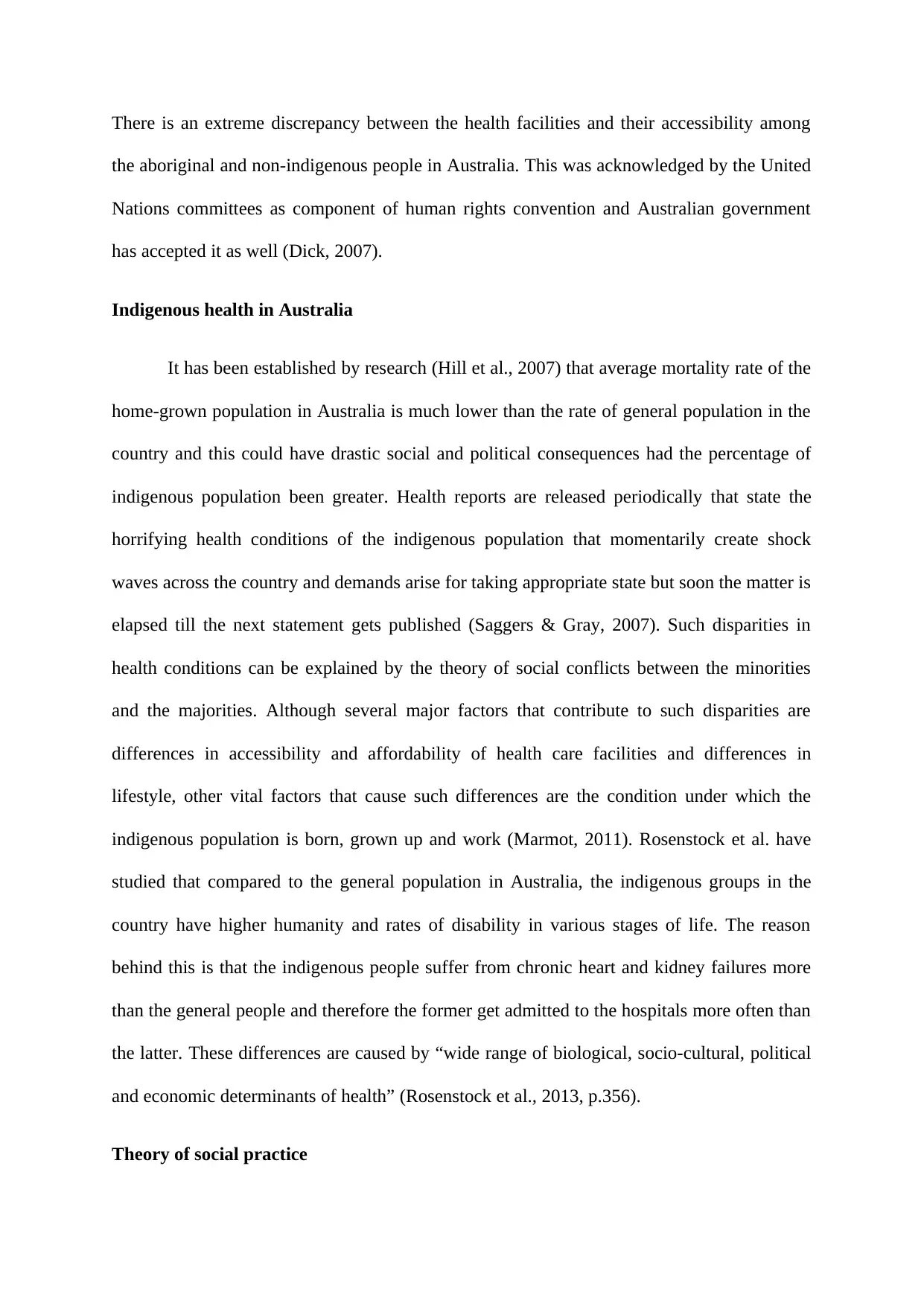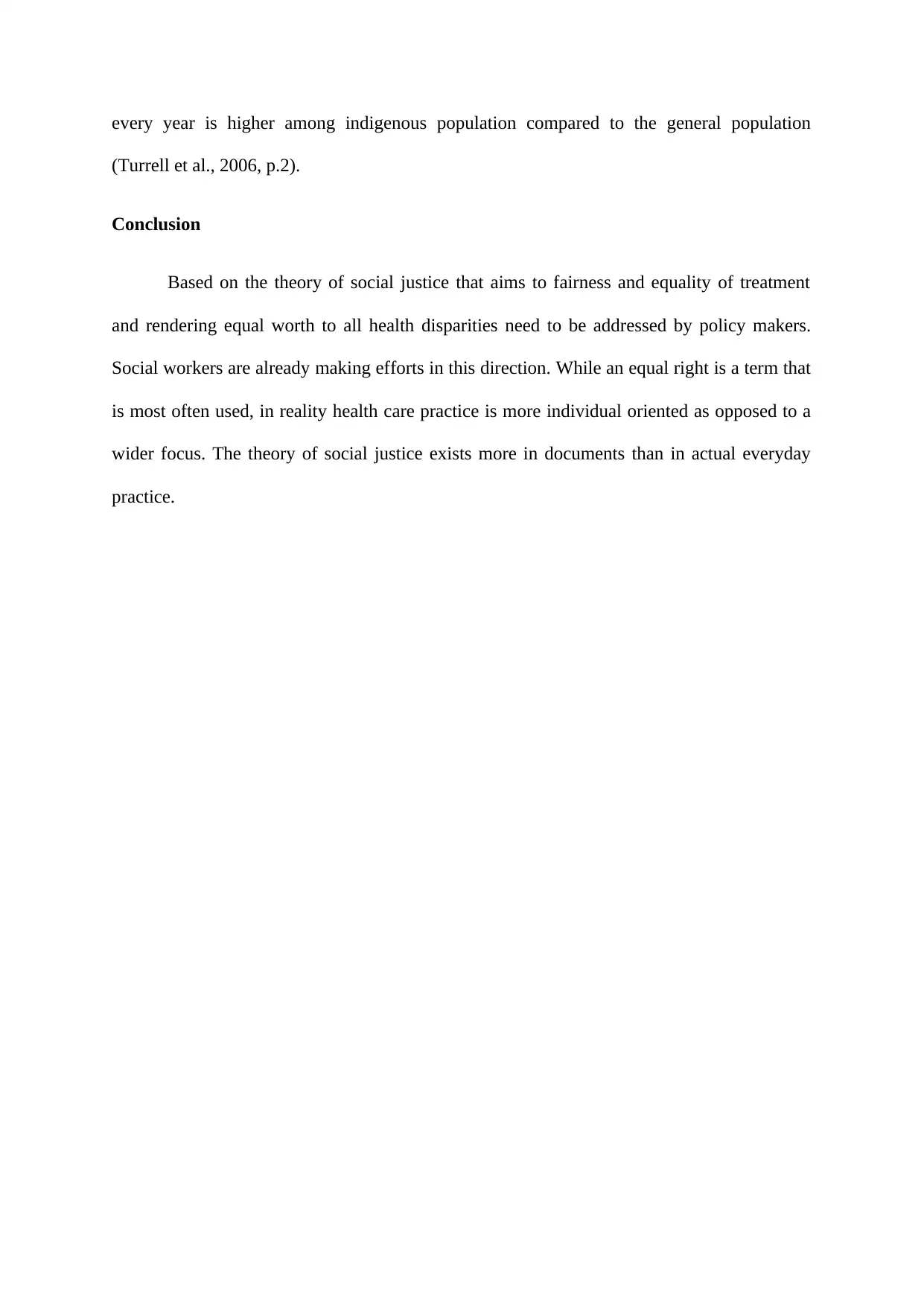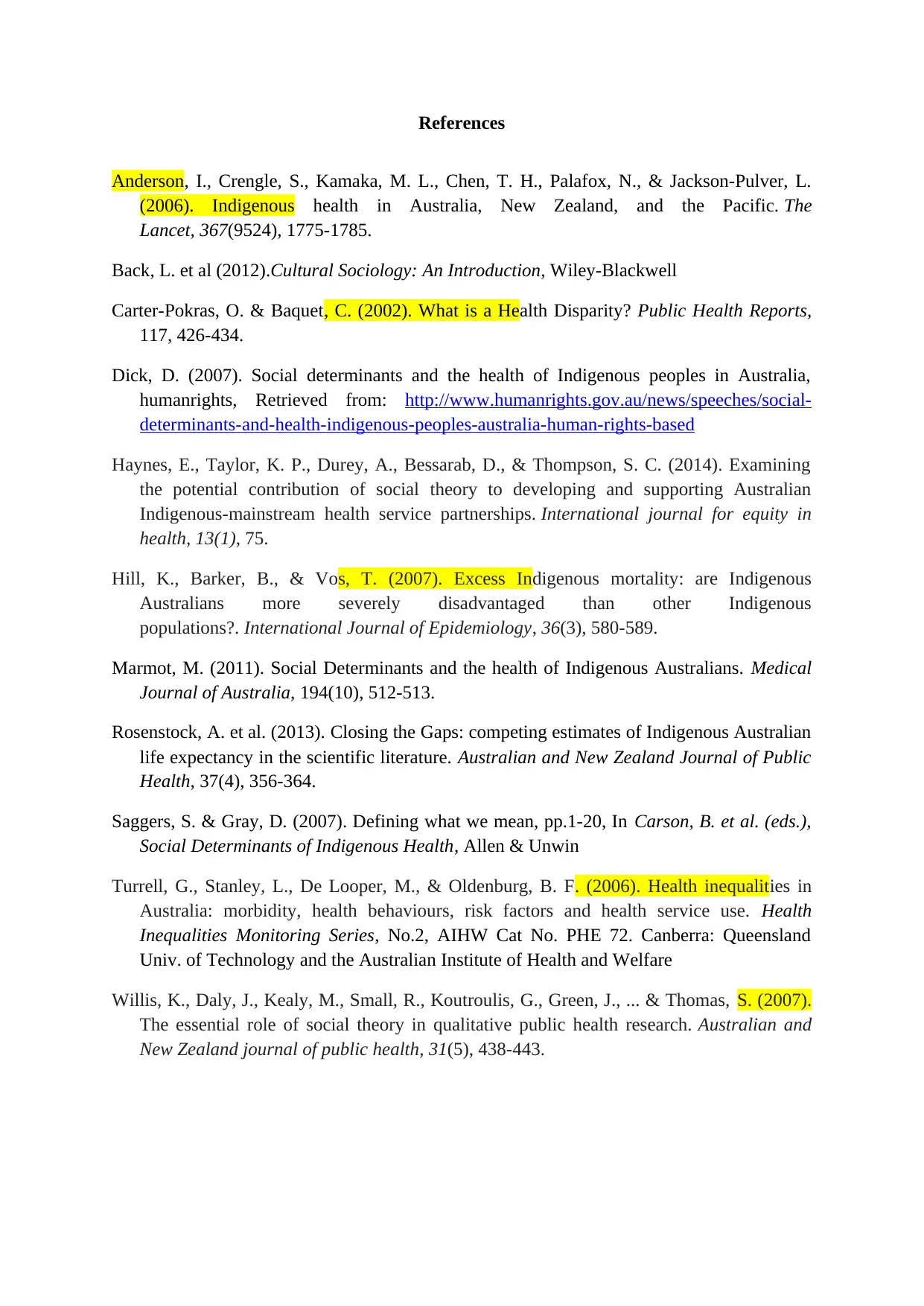The Impact of Social Theories on Indigenous Health in Australia
VerifiedAdded on 2023/01/11
|5
|1637
|54
Essay
AI Summary
This essay delves into the application of social theories, particularly conflict theory and the theory of social practice, to understand health disparities within the Australian Indigenous population. It examines the historical and ongoing challenges faced by Indigenous Australians, including significantly lower life expectancies and higher rates of chronic diseases compared to the non-Indigenous population. The essay explores how factors like socioeconomic status, access to healthcare, and systemic inequalities contribute to these disparities. It references key studies and reports, including those from the World Health Organization (WHO), to highlight the severity of health inequities and their impact. Furthermore, the essay discusses the role of social workers and policymakers in addressing these issues, advocating for a social justice approach that prioritizes fairness and equal access to healthcare. The analysis emphasizes the need for comprehensive policy changes and a shift from individual-oriented healthcare practices to a broader focus on societal well-being, aiming to bridge the gap between Indigenous and non-Indigenous health outcomes.

Australian Society, Systems and Policies
In the context of any qualitative research, having a comprehensive knowledge social
theory may seem a challenging requirement. However, the task becomes easier when we
comprehend the extent to which we already apply theories in any study. It is theory that
provides the material for research. Researchers first make assumptions about the nature of
reality and from these suppositions; theoretical notions are born which in turn are collectively
used for practice and research.
Conflict theory
Cultural sociology deals with the theory of the pattern of how people think and act,
and every other material thing that structure the lives of people. One major aspect of
sociological investigation is class. The sociological concept of societal division generally
indicates “a body of theory and evidence that is used to explain the structural reproduction of
inequality within society.” (Back et al., 2012, p.48). The concept of class that exists in all
societies is indicated by the status that is provided to an individual because of his or her
financial condition which in turn is decided by his occupation, level of income, source of
income and other factors. The social position that an individual holds determines his or her
power and rights in the society and this is carried on upon their future generations provided
their social and economic status remains in the same level (Back et al., 2012). This concept of
class has been emphasized by conflict theory that is derived from conflict between social
groups. Max Weber has also extended this theory by arguing that “both class and
membership of social groups determine power, hence the concept of socio-economic status”
(Willis et al., 2007). This conflict theory is evident in the heath care facilities that exist in
Australia for its indigenous people. There exists this eternal confrontation for the Australian
government to improve the average wellbeing status of aboriginal populace in the country.
In the context of any qualitative research, having a comprehensive knowledge social
theory may seem a challenging requirement. However, the task becomes easier when we
comprehend the extent to which we already apply theories in any study. It is theory that
provides the material for research. Researchers first make assumptions about the nature of
reality and from these suppositions; theoretical notions are born which in turn are collectively
used for practice and research.
Conflict theory
Cultural sociology deals with the theory of the pattern of how people think and act,
and every other material thing that structure the lives of people. One major aspect of
sociological investigation is class. The sociological concept of societal division generally
indicates “a body of theory and evidence that is used to explain the structural reproduction of
inequality within society.” (Back et al., 2012, p.48). The concept of class that exists in all
societies is indicated by the status that is provided to an individual because of his or her
financial condition which in turn is decided by his occupation, level of income, source of
income and other factors. The social position that an individual holds determines his or her
power and rights in the society and this is carried on upon their future generations provided
their social and economic status remains in the same level (Back et al., 2012). This concept of
class has been emphasized by conflict theory that is derived from conflict between social
groups. Max Weber has also extended this theory by arguing that “both class and
membership of social groups determine power, hence the concept of socio-economic status”
(Willis et al., 2007). This conflict theory is evident in the heath care facilities that exist in
Australia for its indigenous people. There exists this eternal confrontation for the Australian
government to improve the average wellbeing status of aboriginal populace in the country.
Paraphrase This Document
Need a fresh take? Get an instant paraphrase of this document with our AI Paraphraser

There is an extreme discrepancy between the health facilities and their accessibility among
the aboriginal and non-indigenous people in Australia. This was acknowledged by the United
Nations committees as component of human rights convention and Australian government
has accepted it as well (Dick, 2007).
Indigenous health in Australia
It has been established by research (Hill et al., 2007) that average mortality rate of the
home-grown population in Australia is much lower than the rate of general population in the
country and this could have drastic social and political consequences had the percentage of
indigenous population been greater. Health reports are released periodically that state the
horrifying health conditions of the indigenous population that momentarily create shock
waves across the country and demands arise for taking appropriate state but soon the matter is
elapsed till the next statement gets published (Saggers & Gray, 2007). Such disparities in
health conditions can be explained by the theory of social conflicts between the minorities
and the majorities. Although several major factors that contribute to such disparities are
differences in accessibility and affordability of health care facilities and differences in
lifestyle, other vital factors that cause such differences are the condition under which the
indigenous population is born, grown up and work (Marmot, 2011). Rosenstock et al. have
studied that compared to the general population in Australia, the indigenous groups in the
country have higher humanity and rates of disability in various stages of life. The reason
behind this is that the indigenous people suffer from chronic heart and kidney failures more
than the general people and therefore the former get admitted to the hospitals more often than
the latter. These differences are caused by “wide range of biological, socio-cultural, political
and economic determinants of health” (Rosenstock et al., 2013, p.356).
Theory of social practice
the aboriginal and non-indigenous people in Australia. This was acknowledged by the United
Nations committees as component of human rights convention and Australian government
has accepted it as well (Dick, 2007).
Indigenous health in Australia
It has been established by research (Hill et al., 2007) that average mortality rate of the
home-grown population in Australia is much lower than the rate of general population in the
country and this could have drastic social and political consequences had the percentage of
indigenous population been greater. Health reports are released periodically that state the
horrifying health conditions of the indigenous population that momentarily create shock
waves across the country and demands arise for taking appropriate state but soon the matter is
elapsed till the next statement gets published (Saggers & Gray, 2007). Such disparities in
health conditions can be explained by the theory of social conflicts between the minorities
and the majorities. Although several major factors that contribute to such disparities are
differences in accessibility and affordability of health care facilities and differences in
lifestyle, other vital factors that cause such differences are the condition under which the
indigenous population is born, grown up and work (Marmot, 2011). Rosenstock et al. have
studied that compared to the general population in Australia, the indigenous groups in the
country have higher humanity and rates of disability in various stages of life. The reason
behind this is that the indigenous people suffer from chronic heart and kidney failures more
than the general people and therefore the former get admitted to the hospitals more often than
the latter. These differences are caused by “wide range of biological, socio-cultural, political
and economic determinants of health” (Rosenstock et al., 2013, p.356).
Theory of social practice

Through the lens of Bourdieu’s theory of social practice it can be understood the
existence of power in different population groups in a society or country and the myriad and
radical forces that shape the intercultural dimensions in a society. Bourdieu has argued that
while class differences play a major role in how individuals behave the other factors are the
organizing principles of the concerned field like in healthcare. Bourdieu has defined a
“socially organized space” like the healthcare as a field of “conflict and competition”
(Haynes et al., 2014). People who belong in this field, depending on their social class,
determine who in the society will have the power to access or to not access the resources in
this field. The manner in which intercultural people resolve this conflict is a key factor that
can change the boundaries of the healthcare field. This theory of social practice is reflected in
the health conditions of the indigenous population in Australia. The broad differences in the
health conditions that exist between countries and also within countries is a matter of major
concern in the global arena. Based on the social theories, various factors like class inequities
and social power structure contribute towards such health differences. Therefore, the
important thing is that the subject healthcare must not be the concern solely of the healthcare
sector but policymakers of different sectors. WHO (World Health Organization) defines
health inequity as “difference in health which is not only unnecessary and avoidable but, in
addition, is considered unfair and unjust” (Carter-Pokras & Baquet, 2002, p.427). Australia is
among the most obvious instances of health inequities that exist within the boundaries of a
country. As per 1998-2000 reports, the average life anticipation of the indigenous population
in Australia is 20 years less than the average life expectancy of the population which are not
aboriginals in the country. Moreover, the indigenous population suffer from more health
issues than the general population and they experience lower birth mass and untimely birth
than the general population. In addition, the number of people who get admitted to hospitals
existence of power in different population groups in a society or country and the myriad and
radical forces that shape the intercultural dimensions in a society. Bourdieu has argued that
while class differences play a major role in how individuals behave the other factors are the
organizing principles of the concerned field like in healthcare. Bourdieu has defined a
“socially organized space” like the healthcare as a field of “conflict and competition”
(Haynes et al., 2014). People who belong in this field, depending on their social class,
determine who in the society will have the power to access or to not access the resources in
this field. The manner in which intercultural people resolve this conflict is a key factor that
can change the boundaries of the healthcare field. This theory of social practice is reflected in
the health conditions of the indigenous population in Australia. The broad differences in the
health conditions that exist between countries and also within countries is a matter of major
concern in the global arena. Based on the social theories, various factors like class inequities
and social power structure contribute towards such health differences. Therefore, the
important thing is that the subject healthcare must not be the concern solely of the healthcare
sector but policymakers of different sectors. WHO (World Health Organization) defines
health inequity as “difference in health which is not only unnecessary and avoidable but, in
addition, is considered unfair and unjust” (Carter-Pokras & Baquet, 2002, p.427). Australia is
among the most obvious instances of health inequities that exist within the boundaries of a
country. As per 1998-2000 reports, the average life anticipation of the indigenous population
in Australia is 20 years less than the average life expectancy of the population which are not
aboriginals in the country. Moreover, the indigenous population suffer from more health
issues than the general population and they experience lower birth mass and untimely birth
than the general population. In addition, the number of people who get admitted to hospitals
⊘ This is a preview!⊘
Do you want full access?
Subscribe today to unlock all pages.

Trusted by 1+ million students worldwide

every year is higher among indigenous population compared to the general population
(Turrell et al., 2006, p.2).
Conclusion
Based on the theory of social justice that aims to fairness and equality of treatment
and rendering equal worth to all health disparities need to be addressed by policy makers.
Social workers are already making efforts in this direction. While an equal right is a term that
is most often used, in reality health care practice is more individual oriented as opposed to a
wider focus. The theory of social justice exists more in documents than in actual everyday
practice.
(Turrell et al., 2006, p.2).
Conclusion
Based on the theory of social justice that aims to fairness and equality of treatment
and rendering equal worth to all health disparities need to be addressed by policy makers.
Social workers are already making efforts in this direction. While an equal right is a term that
is most often used, in reality health care practice is more individual oriented as opposed to a
wider focus. The theory of social justice exists more in documents than in actual everyday
practice.
Paraphrase This Document
Need a fresh take? Get an instant paraphrase of this document with our AI Paraphraser

References
Anderson, I., Crengle, S., Kamaka, M. L., Chen, T. H., Palafox, N., & Jackson-Pulver, L.
(2006). Indigenous health in Australia, New Zealand, and the Pacific. The
Lancet, 367(9524), 1775-1785.
Back, L. et al (2012).Cultural Sociology: An Introduction, Wiley-Blackwell
Carter-Pokras, O. & Baquet, C. (2002). What is a Health Disparity? Public Health Reports,
117, 426-434.
Dick, D. (2007). Social determinants and the health of Indigenous peoples in Australia,
humanrights, Retrieved from: http://www.humanrights.gov.au/news/speeches/social-
determinants-and-health-indigenous-peoples-australia-human-rights-based
Haynes, E., Taylor, K. P., Durey, A., Bessarab, D., & Thompson, S. C. (2014). Examining
the potential contribution of social theory to developing and supporting Australian
Indigenous-mainstream health service partnerships. International journal for equity in
health, 13(1), 75.
Hill, K., Barker, B., & Vos, T. (2007). Excess Indigenous mortality: are Indigenous
Australians more severely disadvantaged than other Indigenous
populations?. International Journal of Epidemiology, 36(3), 580-589.
Marmot, M. (2011). Social Determinants and the health of Indigenous Australians. Medical
Journal of Australia, 194(10), 512-513.
Rosenstock, A. et al. (2013). Closing the Gaps: competing estimates of Indigenous Australian
life expectancy in the scientific literature. Australian and New Zealand Journal of Public
Health, 37(4), 356-364.
Saggers, S. & Gray, D. (2007). Defining what we mean, pp.1-20, In Carson, B. et al. (eds.),
Social Determinants of Indigenous Health, Allen & Unwin
Turrell, G., Stanley, L., De Looper, M., & Oldenburg, B. F. (2006). Health inequalities in
Australia: morbidity, health behaviours, risk factors and health service use. Health
Inequalities Monitoring Series, No.2, AIHW Cat No. PHE 72. Canberra: Queensland
Univ. of Technology and the Australian Institute of Health and Welfare
Willis, K., Daly, J., Kealy, M., Small, R., Koutroulis, G., Green, J., ... & Thomas, S. (2007).
The essential role of social theory in qualitative public health research. Australian and
New Zealand journal of public health, 31(5), 438-443.
Anderson, I., Crengle, S., Kamaka, M. L., Chen, T. H., Palafox, N., & Jackson-Pulver, L.
(2006). Indigenous health in Australia, New Zealand, and the Pacific. The
Lancet, 367(9524), 1775-1785.
Back, L. et al (2012).Cultural Sociology: An Introduction, Wiley-Blackwell
Carter-Pokras, O. & Baquet, C. (2002). What is a Health Disparity? Public Health Reports,
117, 426-434.
Dick, D. (2007). Social determinants and the health of Indigenous peoples in Australia,
humanrights, Retrieved from: http://www.humanrights.gov.au/news/speeches/social-
determinants-and-health-indigenous-peoples-australia-human-rights-based
Haynes, E., Taylor, K. P., Durey, A., Bessarab, D., & Thompson, S. C. (2014). Examining
the potential contribution of social theory to developing and supporting Australian
Indigenous-mainstream health service partnerships. International journal for equity in
health, 13(1), 75.
Hill, K., Barker, B., & Vos, T. (2007). Excess Indigenous mortality: are Indigenous
Australians more severely disadvantaged than other Indigenous
populations?. International Journal of Epidemiology, 36(3), 580-589.
Marmot, M. (2011). Social Determinants and the health of Indigenous Australians. Medical
Journal of Australia, 194(10), 512-513.
Rosenstock, A. et al. (2013). Closing the Gaps: competing estimates of Indigenous Australian
life expectancy in the scientific literature. Australian and New Zealand Journal of Public
Health, 37(4), 356-364.
Saggers, S. & Gray, D. (2007). Defining what we mean, pp.1-20, In Carson, B. et al. (eds.),
Social Determinants of Indigenous Health, Allen & Unwin
Turrell, G., Stanley, L., De Looper, M., & Oldenburg, B. F. (2006). Health inequalities in
Australia: morbidity, health behaviours, risk factors and health service use. Health
Inequalities Monitoring Series, No.2, AIHW Cat No. PHE 72. Canberra: Queensland
Univ. of Technology and the Australian Institute of Health and Welfare
Willis, K., Daly, J., Kealy, M., Small, R., Koutroulis, G., Green, J., ... & Thomas, S. (2007).
The essential role of social theory in qualitative public health research. Australian and
New Zealand journal of public health, 31(5), 438-443.
1 out of 5
Related Documents
Your All-in-One AI-Powered Toolkit for Academic Success.
+13062052269
info@desklib.com
Available 24*7 on WhatsApp / Email
![[object Object]](/_next/static/media/star-bottom.7253800d.svg)
Unlock your academic potential
Copyright © 2020–2025 A2Z Services. All Rights Reserved. Developed and managed by ZUCOL.





